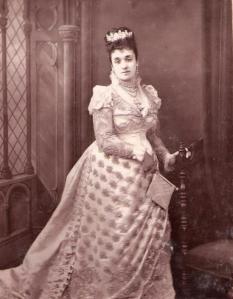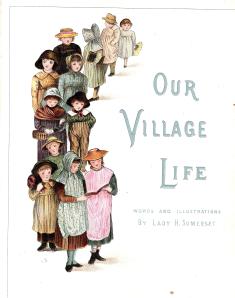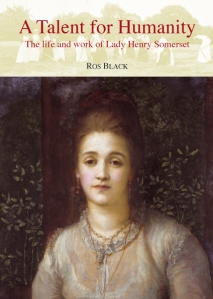A Talent for Humanity – the life and work of Lady Henry Somerset is an easy to read biography of an amazing woman. It has been described as a real ‘page-turner’. Click on the Buy the books page to purchase from Amazon.
In her day, Lady Henry Somerset was compared to Florence Nightingale. She topped a poll of readers of the London Evening News as the person they would most like as the first female Prime Minister. Yet today she is not well known, perhaps because she championed the temperance cause and this has long gone out of fashion.
The story of her life is fascinating; the list of her achievements long and varied. She overcame the sorrow of an unhappy marriage to become a leading social reformer, a powerful orator who could pack halls around Britain and throughout America. She promoted women’s issues well before feminism became a popular movement.
Isabel Caroline Somers Cocks was the eldest daughter of Charles, 3rd Earl Somers. Her mother, Virginia, was a renowned socialite and beauty. The family owned great swathes of land in Herefordshire and Worcestershire, including Eastnor Castle, as well as most of the town of Reigate in Surrey where they had a fine country house, Reigate Priory. They also owned much of the less salubrious Somers Town, in the St Pancras area of London.
 Photo courtesy of The Holmesdale Natural History Museum, Reigate.
Photo courtesy of The Holmesdale Natural History Museum, Reigate.
In 1872, as a shy 20-year-old, Isabel married Lord Henry Somerset, second son of the Duke of Beaufort. A glittering life of aristocratic pleasures seemed to lie ahead of her. Sadly her hopes of a happy marriage and a large family were dashed within days of her society wedding; the honeymoon at Reigate Priory was a disaster.
To Isabel’s dismay, her husband announced he wanted them to lead separate lives. She could not understand what she had done wrong. For a brief period marital relations were resumed and a son was born. But Isabel could not turn a blind eye to her husband’s behaviour. For Lord Henry was a homosexual and at that time, homosexuality was not just frowned upon, it was a crime.
It took Lady Henry several difficult years to escape from the marriage. In challenging her husband, Comptroller of the Queen’s Household and a protégé of Disraeli, for custody of their son, she flouted all the social conventions of the period. She may have won the court case, but it was a hollow victory as she was the one then shunned by society. Gossip spread that she had “invented a new sin”, something only mentioned in the Bible and gentlemen did not want their wives associating with her.
For several years, Isabel nursed her hurt pride, living primarily at Reigate Priory. It was here that she had a moment of divine revelation. As she sat under the shade of a tree by the Priory lake, weighed down by worries, she queried the very existence of God. Then, as she later recounted, she heard a voice as if from deep within herself saying, “Act as if I am and thou shalt know I am”. From that time on, her religious conviction never waivered. Although, at one stage, she flirted with Methodist teaching, in later life she became increasingly High Anglican.
Following the death of her father, she moved back to Eastnor where she began to visit the sick and needy. Distressed by the alcohol-fuelled squalor of Ledbury’s Bye Street, she set up a mission and encouraged people to sign the Total Abstinence Pledge. She led by example and took the pledge herself.
In 1890, Lady Henry became President of the British Women’s Temperance Association (BWTA) and set about expanding its remit, refusing to be the titled figurehead some people had thought they were electing.
When not on the campaign trail, arguing for the restriction of opening hours rather than the full prohibition favoured by her American colleagues, she preferred to offer practical help. She set up homes in both Eastnor and Reigate where young girls, often from the workhouse, could be trained for domestic service. She established a settlement in the East End of London.
 Our Village Life, a delightful selction of children’s poems, was written and illustrated by Lady Henry Somerset to raise funds for St Mary’s Home in Reigate.
Our Village Life, a delightful selction of children’s poems, was written and illustrated by Lady Henry Somerset to raise funds for St Mary’s Home in Reigate.
Isabel was one of those women who always had to be busy. She was multi-talented: an author, journalist, artist, sculptor. Most importantly she had what Chekhov described as “a talent for humanity”. Despite her own health problems, she espoused many social causes, not just those relating to drug and alcohol abuse.
Her friendship with the American temperance leader, Frances Willard, brought her some comfort but she was at times extremely lonely. She chastised herself for being interested in the theatre and the arts and even society gossip and always thought she could be doing more for others less fortunate than herself.
She was a woman who saw not only the bigger picture – a liquor trade which was almost uncontrolled, due to vested interests and the ability of governments around the world to raise taxes from its sale – but also the intimate portrait of the family or individual whose life had been blighted by alcohol abuse.
She would campaign tirelessly, lobbying governments and politicians of all parties. She would address huge rallies, leading carriage processions round Hyde Park. She would go down the pits to talk to miners about God’s love for them.
She even bought her own newspaper, the Woman’s Herald, which later evolved into Woman’s Signal, to promulgate her message of restraint.
But words, however powerful and eloquently delivered, were not enough for Isabel. Action was required; action which made a real difference to the lives of real people, whatever their class or rank in society; action which proved without words that each person was valued, whatever their circumstances.
Her own experience as a victim of society’s harsh and ill-informed censure, following her separation from her husband, gave her a special empathy with those less fortunate. It also gave her the sense to realize that often there was often a story behind a person’s behaviour which was not always apparent to the casual observer. It meant she started to look into the causes of alcoholism, not just the effects.
Isabel’s cousin and staunch supporter, the Reverend E. F. Russell, recounted another reason for Isabel’s compassion for women suffering from alcohol and drug abuse.
“ … her own dearest friend, a lady of great gifts, and great charm, fell a victim to the seductive habit [excessive alcohol consumption], which dragged her gradually down, until at last she perished by her own hand.”
Isabel was very strong-willed and not afraid to fight for her beliefs. Not surprisingly her approach upset some of her fellow campaigners and under her presidency there were many internal battles within the British Women’s Temperance Association. In 1893, the inevitable happened and those who did not agree with her reforming agenda broke away to form their own Women’s Total Abstinence Union.
This gave Isabel more scope to progress some of her schemes. Whilst the BWTA had had a house at Sydenham for the care of inebriate women, Isabel was content for this to go to the breakaway faction. She had grander ideas. She didn’t just want a house, she wanted a whole village.
In November 1893, Isabel secured the passing of a resolution of the Annual Council of the renamed National British Women’s Temperance Association (NBWTA) to launch an appeal for funds to establish an Industrial Farm Village. And just three miles south of her own Reigate home, she found the perfect site – Duxhurst.
For further articles about Lady Henry Somerset and Duxhurst, click on the categories on the right of the screen.



Pingback: » Downton Abbey Gives Me Clues About My Grandmother
Hi This is fascinating and I love the photo.
Lady Henry actually had 2 homes, both called St Mary’s, 1 at Eastnor (Herefordshire) and 1 in Reigate (Surrey) where she took in young girls from the workhouses and had them trained in domestic skills. They were then often placed in the households of her family and friends. In the homes, they were also encouraged to join The Band of Hope, a teetotal group for young people. Religion was also very important.
I love the fact that your Gramma went out to Australia with Lord Somers and Finola. She must have had an incredible life. It’s such a shame you weren’t able to persuade her to tell you some of her stories.
If you haven’t already read my biography of Lady Henry Somerset, A Talent for Humanity – the Life and Work of Lady Henry Somerset, I would recommend it as it will give you a good insight into the early life of your ancestor.
Thanks for getting in touch
Ros
Lady Henry Somerset is buried in the St Alban’s the Martyr Church graveyard in Brookwood cemetry.
I was there today with my church to bury my father’s ashes and saw a grave sheltered by the undergrowth, which caught my attention. it was that of Lady Somerset, which I did not expect to find in our paris church graveyard.
Hi Lisa
Firstly condolences on the loss of your father.
Apologies for not replying earlier – sadly I too have had a recent bereavement.
You did well to spot Lady Henry Somerset’s grave at Brookwood, which is of course the graveyard for many London churches. She chose to be buried out of her church of St Albans in Holborn, as by the time of her death she was living primarily in either her flat in Gray’s Inn or at Duxhurst. As you will appreciate she could have been buried in the Somers family vault at Eastnor but she had passed that estate over to her cousin Arthur (the male heir) and had effectively shaken off her aristocratic shackles. She had made provision to be buried in the churchyard at Duxhurst, but must have changed her mind. Her cousin the Rev E F Russell was based at St Albans Church (he too is buried at Brookwood, close to Lady Henry’s grave) and this may well have been the determining factor, especially as he was very supportive of her work.
Ros
Hi. I have just purchased your book today. I came Cross it when researching Duxhurst and Lady Henry Somerset in relation to my great aunt Mary Anita PELLS. In 1918 – 1919 Mary Anita was residing with Lady Henry not as a recovering alcoholic but perhaps as a nurse. I wonder if you came across her name during your research?
Hi Rebecca
I hope you enjoy the book. Sadly despite extensive research I have never been able to find any records of patients or staff at Duxhurst. I suspect these were destroyed. I didn’t come across your great aunt’s name in my research but obviously there were a lot of staff there and she may have been involved with caring for the children which was an increasing important feature of Duxhurst life in 1918-19. Best wishes Ros
Thanks so much for your reply Ros.
Henry Sackett of the Somerset House born 1851 in Essex, England. He removed to Texas, and founded Coleman, Texas in Coleman County.
His father is Henry Sackett born 1803 at the Somerset House. His father is Henry Sackett born 1738. His father is King George III.
I AM HENRY SOMERSET’S 4th GREAT GRANDDAUGHTER.
Perhaps you could send me more details.